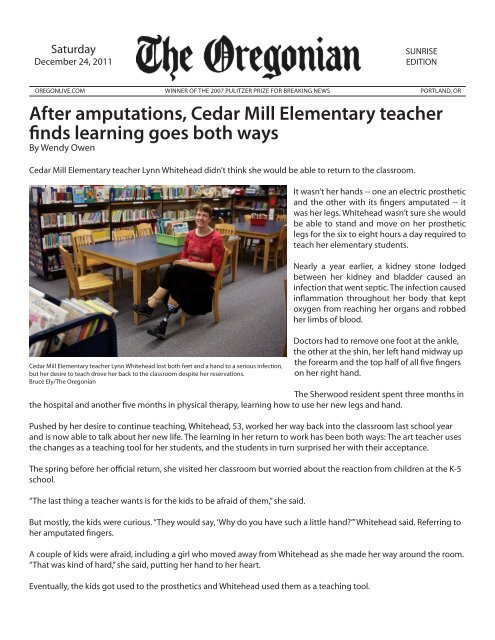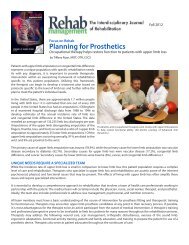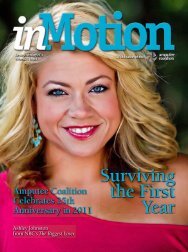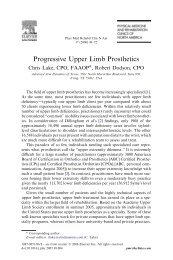After amputations, Cedar Mill Elementary teacher finds learning ...
After amputations, Cedar Mill Elementary teacher finds learning ...
After amputations, Cedar Mill Elementary teacher finds learning ...
Create successful ePaper yourself
Turn your PDF publications into a flip-book with our unique Google optimized e-Paper software.
Saturday<br />
December 24, 2011<br />
SUNRISE<br />
EDITION<br />
OREGONLIVE.COM<br />
WINNER OF THE 2007 PULITZER PRIZE FOR BREAKING NEWS<br />
<strong>After</strong> <strong>amputations</strong>, <strong>Cedar</strong> <strong>Mill</strong> <strong>Elementary</strong> <strong>teacher</strong><br />
<strong>finds</strong> <strong>learning</strong> goes both ways<br />
By Wendy Owen<br />
<strong>Cedar</strong> <strong>Mill</strong> <strong>Elementary</strong> <strong>teacher</strong> Lynn Whitehead didn’t think she would be able to return to the classroom.<br />
<strong>Cedar</strong> <strong>Mill</strong> <strong>Elementary</strong> <strong>teacher</strong> Lynn Whitehead lost both feet and a hand to a serious infection,<br />
but her desire to teach drove her back to the classroom despite her reservations.<br />
Bruce Ely/The Oregonian<br />
It wasn’t her hands -- one an electric prosthetic<br />
and the other with its fingers amputated -- it<br />
was her legs. Whitehead wasn’t sure she would<br />
be able to stand and move on her prosthetic<br />
legs for the six to eight hours a day required to<br />
teach her elementary students.<br />
Nearly a year earlier, a kidney stone lodged<br />
between her kidney and bladder caused an<br />
infection that went septic. The infection caused<br />
inflammation throughout her body that kept<br />
oxygen from reaching her organs and robbed<br />
her limbs of blood.<br />
Doctors had to remove one foot at the ankle,<br />
the other at the shin, her left hand midway up<br />
the forearm and the top half of all five fingers<br />
on her right hand.<br />
The Sherwood resident spent three months in<br />
the hospital and another five months in physical therapy, <strong>learning</strong> how to use her new legs and hand.<br />
Pushed by her desire to continue teaching, Whitehead, 53, worked her way back into the classroom last school year<br />
and is now able to talk about her new life. The <strong>learning</strong> in her return to work has been both ways: The art <strong>teacher</strong> uses<br />
the changes as a teaching tool for her students, and the students in turn surprised her with their acceptance.<br />
The spring before her official return, she visited her classroom but worried about the reaction from children at the K-5<br />
school.<br />
“The last thing a <strong>teacher</strong> wants is for the kids to be afraid of them,” she said.<br />
But mostly, the kids were curious. “They would say, ‘Why do you have such a little hand?’” Whitehead said. Referring to<br />
her amputated fingers.<br />
A couple of kids were afraid, including a girl who moved away from Whitehead as she made her way around the room.<br />
“That was kind of hard,” she said, putting her hand to her heart.<br />
Eventually, the kids got used to the prosthetics and Whitehead used them as a teaching tool.<br />
PORTLAND, OR
When she returned, she sat down and talked to the kids about her new hand and legs. She showed them pictures of<br />
animals with prosthetic limbs, including an elephant.<br />
She allowed the students to try out her electric hand. The boys, as expected, wanted one of their own.<br />
“It didn’t really matter what she looked like,” said Ella DeVeaux, 8. “She’s nice on the inside.”<br />
Whitehead always warns the kids before taking off the hand, which extends up her forearm. What remains is not<br />
scarred or ugly. It’s simply her forearm, smooth skinned and rounded.<br />
“It was a little scary, but then I got used to it,” said Eva Muir, 9.<br />
Whitehead is proud of the students.<br />
“They’re so accepting of the whole thing,” she said. “I’m real open about the frustrations. They’re like family, they just<br />
kind of watch me.”<br />
She’s made an impression on them as well, especially the older kids.<br />
“I don’t think I would come back because I would be embarrassed,” said Schuyler Dull, 11. “Mrs. Whitehead has inspired<br />
me.”<br />
Whitehead, who is married and has two grown sons, has taught at <strong>Cedar</strong> <strong>Mill</strong> for 12 years and is a popular instructor.<br />
She teaches art part-time, which was her job before the <strong>amputations</strong>.<br />
“She provides a wonderful model of endurance, fighting spirit and grit,” <strong>Cedar</strong> <strong>Mill</strong> Principal Brian Horne said in an<br />
email.<br />
As winter break approached, Whitehead worked with students on sculpting clay, but she also teaches them drawing,<br />
collage, stitching, papier-mâché and acrylic painting. She has found ways to demonstrate the artwork she wants the<br />
students to create.<br />
Her prosthetic specialist MacJulian Lang, of Advanced Arm Dynamics in Tigard, said it helps that doctors were able to<br />
save most of her right hand. “She needs at least one side with intact sensation and finer use than the prosthetic,” he<br />
said.<br />
The prosthetic hand is electric, and sensors at the top of the device read the electrical activity when she contracts<br />
muscles in her arm. Whitehead must think about opening or closing her hand, bending it up or down and the sensors<br />
read the muscles and perform the activity with the hand.<br />
“She can vary the speed of the hand by how strong she makes a muscle,” Lang said.<br />
Whitehead said her legs are more difficult to use than the arm.<br />
“It’s like walking on stilts,” she said. Stairs and slopes are especially difficult because there is little flex in the ankles.<br />
“She is a role model,” said Kathy Smyth, fourth-grade <strong>teacher</strong>. “The minute we get the urge to grinch about something,<br />
we think of her. She is incredible.”<br />
Whitehead’s desire to continue teaching played a big part in her determination to return to a regular life. “The role in<br />
my recovery was huge,” she said, of teaching. “There have been times when I didn’t think I could do it.”<br />
But, she added, “I’m a pretty stubborn person, and that works in my favor.”










